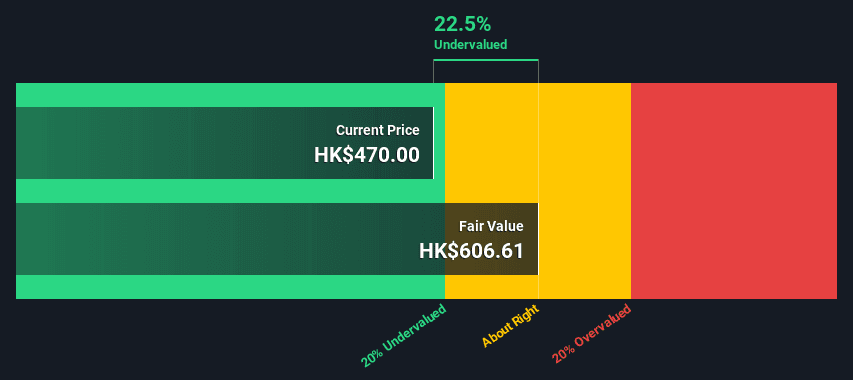Does the February share price for Tencent Holdings Limited (HKG:700) reflect what it's really worth? Today, we will estimate the stock's intrinsic value by taking the expected future cash flows and discounting them to their present value. We will take advantage of the Discounted Cash Flow (DCF) model for this purpose. Don't get put off by the jargon, the math behind it is actually quite straightforward.
We generally believe that a company's value is the present value of all of the cash it will generate in the future. However, a DCF is just one valuation metric among many, and it is not without flaws.
What's the estimated valuation?
We are going to use a two-stage DCF model, which, as the name states, takes into account two stages of growth. The first stage is generally a higher growth period which levels off heading towards the terminal value, captured in the second 'steady growth' period. To begin with, we have to get estimates of the next ten years of cash flows. Where possible we use analyst estimates, but when these aren't available we extrapolate the previous free cash flow (FCF) from the last estimate or reported value. We assume companies with shrinking free cash flow will slow their rate of shrinkage, and that companies with growing free cash flow will see their growth rate slow, over this period. We do this to reflect that growth tends to slow more in the early years than it does in later years.
A DCF is all about the idea that a dollar in the future is less valuable than a dollar today, so we discount the value of these future cash flows to their estimated value in today's dollars:
10-year free cash flow (FCF) forecast
| 2022 | 2023 | 2024 | 2025 | 2026 | 2027 | 2028 | 2029 | 2030 | 2031 | |
| Levered FCF (CN¥, Millions) | CN¥170.3b | CN¥200.6b | CN¥218.1b | CN¥206.2b | CN¥261.5b | CN¥276.8b | CN¥289.3b | CN¥299.8b | CN¥308.7b | CN¥316.5b |
| Growth Rate Estimate Source | Analyst x12 | Analyst x11 | Analyst x2 | Analyst x1 | Analyst x1 | Est @ 5.84% | Est @ 4.53% | Est @ 3.62% | Est @ 2.98% | Est @ 2.53% |
| Present Value (CN¥, Millions) Discounted @ 7.0% | CN¥159.2k | CN¥175.2k | CN¥178.1k | CN¥157.3k | CN¥186.5k | CN¥184.5k | CN¥180.2k | CN¥174.6k | CN¥168.0k | CN¥161.0k |
("Est" = FCF growth rate estimated by Simply Wall St)
Present Value of 10-year Cash Flow (PVCF)= CN¥1.7t
The second stage is also known as Terminal Value, this is the business's cash flow after the first stage. For a number of reasons a very conservative growth rate is used that cannot exceed that of a country's GDP growth. In this case we have used the 5-year average of the 10-year government bond yield (1.5%) to estimate future growth. In the same way as with the 10-year 'growth' period, we discount future cash flows to today's value, using a cost of equity of 7.0%.
Terminal Value (TV)= FCF2031× (1 + g) ÷ (r – g) = CN¥317b× (1 + 1.5%) ÷ (7.0%– 1.5%) = CN¥5.8t
Present Value of Terminal Value (PVTV)= TV / (1 + r)10= CN¥5.8t÷ ( 1 + 7.0%)10= CN¥3.0t
The total value, or equity value, is then the sum of the present value of the future cash flows, which in this case is CN¥4.7t. To get the intrinsic value per share, we divide this by the total number of shares outstanding. Compared to the current share price of HK$470, the company appears a touch undervalued at a 23% discount to where the stock price trades currently. The assumptions in any calculation have a big impact on the valuation, so it is better to view this as a rough estimate, not precise down to the last cent.

The calculation above is very dependent on two assumptions. The first is the discount rate and the other is the cash flows. You don't have to agree with these inputs, I recommend redoing the calculations yourself and playing with them. The DCF also does not consider the possible cyclicality of an industry, or a company's future capital requirements, so it does not give a full picture of a company's potential performance. Given that we are looking at Tencent Holdings as potential shareholders, the cost of equity is used as the discount rate, rather than the cost of capital (or weighted average cost of capital, WACC) which accounts for debt. In this calculation we've used 7.0%, which is based on a levered beta of 1.116. Beta is a measure of a stock's volatility, compared to the market as a whole. We get our beta from the industry average beta of globally comparable companies, with an imposed limit between 0.8 and 2.0, which is a reasonable range for a stable business.
Valuation is only one side of the coin in terms of building your investment thesis, and it is only one of many factors that you need to assess for a company. It's not possible to obtain a foolproof valuation with a DCF model. Instead the best use for a DCF model is to test certain assumptions and theories to see if they would lead to the company being undervalued or overvalued. For example, changes in the company's cost of equity or the risk free rate can significantly impact the valuation. Can we work out why the company is trading at a discount to intrinsic value? For Tencent Holdings, we've put together three additional factors you should consider:
- Risks
- Future Earnings
- Other High Quality Alternatives
Comments